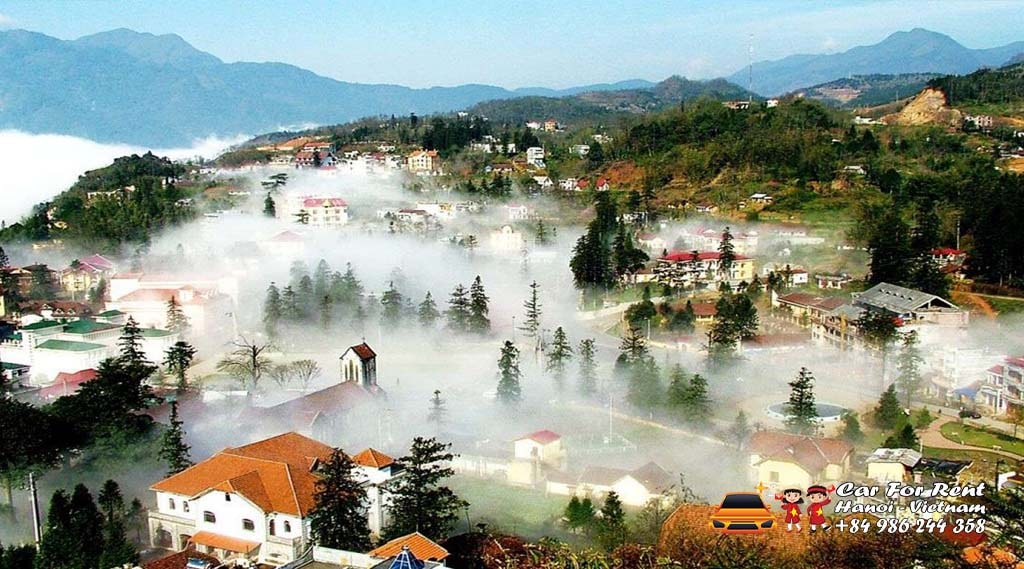sapa vietnam travel Sapa is a town in the northwest of Vietnam, famous for its stunning scenery of mountains, rice terraces, and ethnic minority villages. Sapa is also known as the “Land of Clouds” because of its high altitude and misty weather. Sapa is a popular destination for travelers who want to experience the natural beauty and cultural diversity of Vietnam.
In this blog post, I will share with you some tips and information on how to plan your Sapa Vietnam travel, including:
- How to get to Sapa from Hanoi
- When to visit Sapa and what to pack
- Where to stay and what to eat in Sapa
- What to do and see in Sapa and its surroundings
- How to respect the local culture and environment in Sapa
Read More: Sapa vietnam travel, Car rental hanoi to sapa, Sapa vietnam travel blog, Private Car Hanoi to Sapa
How to get to Sapa from Hanoi
There are two main ways to get to Sapa from Hanoi: by train or by bus.

By train
Taking the train is the most comfortable and scenic way to travel to Sapa. The train journey takes about 8 hours and you can choose between different classes of service, from hard seats to soft sleepers. The train departs from Hanoi Railway Station in the evening and arrives at Lao Cai Station in the early morning. From Lao Cai, you need to take a shuttle bus or a taxi to Sapa town, which takes about an hour.
The train tickets can be booked online or at the station, but it is advisable to book in advance, especially during peak seasons. The price ranges from 150,000 VND ($6.5) to 800,000 VND ($35) per person, depending on the class and the season.
By bus
Taking the bus is the cheapest and fastest way to travel to Sapa. The bus journey takes about 5 hours and you can choose between different types of buses, from standard seats to sleeper beds. The bus departs from various locations in Hanoi, such as My Dinh Bus Station or Old Quarter, and arrives at Sapa Bus Station in the center of town.
The bus tickets can be booked online or at the station, but it is advisable to book in advance, especially during peak seasons. The price ranges from 200,000 VND ($9) to 400,000 VND ($17) per person, depending on the type and the season.

When to visit Sapa and what to pack
Sapa has four seasons: spring (March-May), summer (June-August), autumn (September-November), and winter (December-February). Each season has its own charm and challenges.
Spring
Spring is the best time to visit Sapa if you want to see the blooming flowers and green fields. The temperature is mild and pleasant, ranging from 15°C to 25°C. However, spring is also the rainy season in Sapa, so be prepared for some showers and foggy days. You should pack a raincoat or an umbrella, as well as some warm clothes for the nights.
Summer
Summer is the peak season for tourism in Sapa, as many domestic travelers come here to escape the heat of the lowlands. The temperature is hot and humid, ranging from 20°C to 30°C. However, summer is also the stormy season in Sapa, so be prepared for some thunderstorms and landslides. You should pack light clothes, sunscreen, insect repellent, and a hat.

Autumn
Autumn is the best time to visit Sapa if you want to see the golden rice terraces and clear blue skies. The temperature is cool and dry, ranging from 10°C to 20°C. However, autumn is also the busy season in Sapa, so be prepared for some crowds and higher prices. You should pack warm clothes, hiking shoes, and a camera.
Winter
Winter is the best time to visit Sapa if you want to see the snow-capped mountains and experience the coldest weather in Vietnam. The temperature is cold and frosty, ranging from 0°C to 10°C. However, winter is also the low season in Sapa, so be prepared for some closed attractions and limited services. You should pack thick clothes, gloves, scarves, and a heater.
Where to stay and what to eat in Sapa
Sapa offers a wide range of accommodation options for different budgets and preferences. You can choose between hotels, homestays, hostels, or resorts, depending on your taste and needs. Some of the best places to stay in Sapa are:
- Sapa Centre Hotel: A cozy and convenient hotel in the heart of town, with spacious rooms, friendly staff, and a rooftop restaurant. The price is about 500,000 VND ($22) per night for a double room.
- Sapa Eco Bungalows & Spa: A charming and eco-friendly resort in the middle of nature, with bamboo bungalows, organic gardens, and a spa. The price is about 800,000 VND ($35) per night for a bungalow.
- Sapa Clay House: A unique and authentic homestay in a traditional clay house, with stunning views of the mountains and valleys, and delicious home-cooked meals. The price is about 300,000 VND ($13) per night for a bed in a shared room.
- Sapa Backpackers Hostel: A fun and social hostel in the center of town, with dorm beds, private rooms, and a lively bar. The price is about 100,000 VND ($4) per night for a bed in a dorm.
Sapa also offers a wide range of food options for different tastes and budgets. You can choose between Vietnamese, Western, or ethnic minority cuisine, depending on your mood and appetite. Some of the best places to eat in Sapa are:
- Little Sapa Restaurant: A popular and cozy restaurant that serves authentic Vietnamese dishes, such as pho, spring rolls, and hot pot. The price is about 50,000 VND ($2) per dish.
- Le Gecko Restaurant: A stylish and elegant restaurant that serves French and Italian dishes, such as pizza, pasta, and steak. The price is about 150,000 VND ($6.5) per dish.
- Hill Station Signature Restaurant: A rustic and atmospheric restaurant that serves ethnic minority dishes, such as grilled fish, bamboo rice, and buffalo meat. The price is about 100,000 VND ($4) per dish.
- Sapa O’Chau Cafe: A social enterprise and fair trade cafe that supports local communities and provides training and employment opportunities for ethnic minority youth. The cafe serves coffee, tea, cakes, and snacks. The price is about 30,000 VND ($1.3) per item.

What to do and see in Sapa and its surroundings
Sapa has a lot to offer for travelers who love nature and culture. You can do and see many things in Sapa and its surroundings, such as:
- Trekking: One of the most popular activities in Sapa is trekking through the rice terraces and villages, where you can admire the scenery, interact with the locals, and learn about their culture and lifestyle. You can choose between different levels of difficulty and duration, from half-day to multi-day treks. You can also hire a local guide or join a group tour for a better experience. The price ranges from 200,000 VND ($9) to 1,000,000 VND ($43) per person, depending on the length and the service.
- Fansipan: Another popular activity in Sapa is climbing Fansipan, the highest mountain in Indochina, with an elevation of 3,143 meters. You can either hike to the summit, which takes about 2 to 3 days, or take a cable car, which takes about 15 minutes. Either way, you will be rewarded with breathtaking views of the clouds and the landscape. The price for hiking is about 2,000,000 VND ($86) per person, including a guide and a porter. The price for the cable car is about 700,000 VND ($30) per person, including a shuttle bus and an entrance fee.
- Markets: Another popular activity in Sapa is visiting the markets, where you can see the colorful and lively trade of the ethnic minority people. You can buy some souvenirs, such as handicrafts, textiles, jewelry, or fruits. You can also try some local delicacies, such as corn wine, honey, or dried meat. The markets are held on different days of the week in different locations, such as Bac Ha Market on Sundays, Coc Ly Market on Tuesdays, or Can Cau Market on Saturdays. The price for a market tour is about 500,000 VND ($22) per person, including transportation and a guide.
- Waterfalls: Another popular activity in Sapa is visiting the waterfalls, where you can enjoy the refreshing and relaxing sound of water. You can also swim or picnic near some of the waterfalls. Some of the most beautiful waterfalls in Sapa are Thac Bac (Silver Waterfall), Thac Tinh Yeu (Love Waterfall), and Thac Cat Cat (Cat Cat Waterfall). The price for a waterfall tour is about 300,000 VND ($13) per person, including transportation and a guide.

How to respect the local culture and environment in Sapa
Sapa is a place where you can learn a lot about the rich and diverse culture and environment of Vietnam. However, it is also a place where you need to be respectful and responsible as a traveler. Here are some tips on how to respect the local culture and environment in Sapa:
- Dress modestly and appropriately, especially when visiting temples, pagodas, or villages. Avoid wearing shorts, skirts, or tank tops that expose too much skin or cleavage.
- Ask for permission before taking photos of people or their belongings. Some ethnic minority people may not like to be photographed or may expect some money in return.
- Do not give money or candy to children or beggars, as this may encourage them to rely on handouts or skip school. Instead, donate to a reputable charity or organization that supports the local community.
- Do not buy products made from endangered animals or plants, such as ivory, rhino horn, or orchids. This may contribute to the illegal wildlife trade or the destruction of the natural habitat.
- Do not litter or waste water or electricity. Dispose of your trash properly or bring it back with you. Use reusable bottles or bags instead of plastic ones. Turn off the lights and appliances when not in use.
- Do not pick flowers or fruits from the fields or gardens without permission. This may damage the crops or offend the owners.
- Do not touch or disturb the animals or plants in the wild. This may harm them or provoke them to attack you.

Conclusion
Sapa Vietnam travel is a wonderful experience that you will never forget. Sapa is a place where you can enjoy the beauty of nature and the diversity of culture in Vietnam. Sapa is also a place where you can challenge yourself and learn new things.
Contact us:
Car For Rent Hanoi VietNam
https://zalo.me/0986244358
I hope this blog post has given you some useful information and tips on how to plan your Sapa Vietnam travel. If you have any questions or comments, please feel free to leave them below. Thank you for reading and happy travels!












